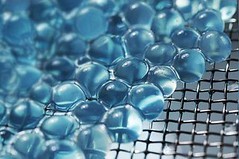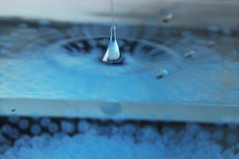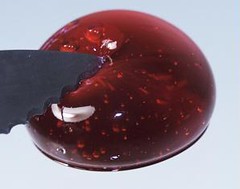
FRUIT CAVIAR REFILL PACK INCLUDES:
(Display fixture sold separately: See Seller Listings)
(Display fixture sold separately: See Seller Listings)
1 - 30mL Syringe Dispenser FREE!
1 - 4 Oz. Sodium Alginate
1 - 4 Oz. Sodium Citrate
1 - 4 Oz. Calcium Chloride
(For approx. 3 gallons of caviar)
Molecular gastronomy is the latest fad among food connoisseurs ever since airing on Top Chef and other shows on the Food Network.
Now you don't have to travel to high end, expensive restaurants to experience molecular gastronomy.
Enjoy the full experience in the comfort of your own kitchen for a fraction of the cost.
Watch this Youtube video taken at the famous Tapas Molecular Bar in Japan: CLICK for "Spherification Video"
=======================================================================================================================================
*Now, what the heck is this big long word?
The word 'sphere' is featured in it. Thus, indeed we are creating spheres. In fact, spherification is the process of making spheres of liquid, any liquid, that has the same texture as caviar. As soon as you bite into it, it burst into your mouth. And with this technique, any liquid can be used... wine, juice, sauce... the possibilities are infinite!
any liquid, that has the same texture as caviar. As soon as you bite into it, it burst into your mouth. And with this technique, any liquid can be used... wine, juice, sauce... the possibilities are infinite!
 any liquid, that has the same texture as caviar. As soon as you bite into it, it burst into your mouth. And with this technique, any liquid can be used... wine, juice, sauce... the possibilities are infinite!
any liquid, that has the same texture as caviar. As soon as you bite into it, it burst into your mouth. And with this technique, any liquid can be used... wine, juice, sauce... the possibilities are infinite! But how? Sodium alginate is a natural extract from brown algae. It is a hydrocolloid, which means it forms a gel when in contact with water. Here, we use a ratio of 1% sodium alginate to liquid. The sodium alginate needs to be dissolved in two times and be sure to let it rest between. It is very hard to dissolve this algae so be patient! And also, it is important to not incorporate too much air when mixing! After the alginate is well dissolved, let it rest for at least 30-45 minutes, the longer the better.
But how? Sodium alginate is a natural extract from brown algae. It is a hydrocolloid, which means it forms a gel when in contact with water. Here, we use a ratio of 1% sodium alginate to liquid. The sodium alginate needs to be dissolved in two times and be sure to let it rest between. It is very hard to dissolve this algae so be patient! And also, it is important to not incorporate too much air when mixing! After the alginate is well dissolved, let it rest for at least 30-45 minutes, the longer the better.While waiting, make the calcium bath. You only have to mix the calcium chloride with the water and let it rest again for at least 30 min.
Now, fill the syringe with the alginate solution and carefully drop the solution in the calcium bath. To make perfect spheres, press the syringe just enough to make the liquid come out and drop into the bath.
Wait around 20-30 seconds and scoop it out with a strainer. Rinse your caviar in cool water to wash off the taste and slow down the spherification.
 What happens? The sodium alginate forms bonds when it comes in contact with the calcium.
What happens? The sodium alginate forms bonds when it comes in contact with the calcium.  While the membrane forms, the interior still stays liquid. However, the reaction is unstable which means that with time, the interior will gellify too. This is why we have to rinse it in water and consume it as soon as possible.
While the membrane forms, the interior still stays liquid. However, the reaction is unstable which means that with time, the interior will gellify too. This is why we have to rinse it in water and consume it as soon as possible.Moreover, the choice of solutions is very important. If the solution is somehow acidic, a buffer will be needed to stabilize it. Sodium citrate is often used.
Once again, a little imagination and a lot of fun can create some very interesting recipes. Combinations such as pearls of orange juice in a glass of champagne to make a mimosa or caviar of balsamic vinegar on a piece bread with some good olive oil...Yummy!